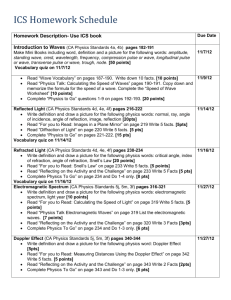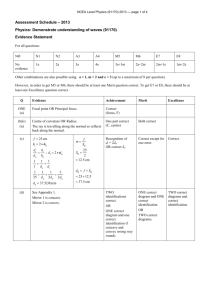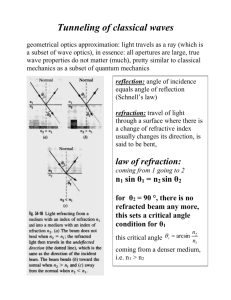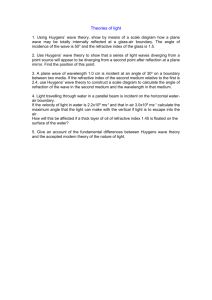MS Word
advertisement
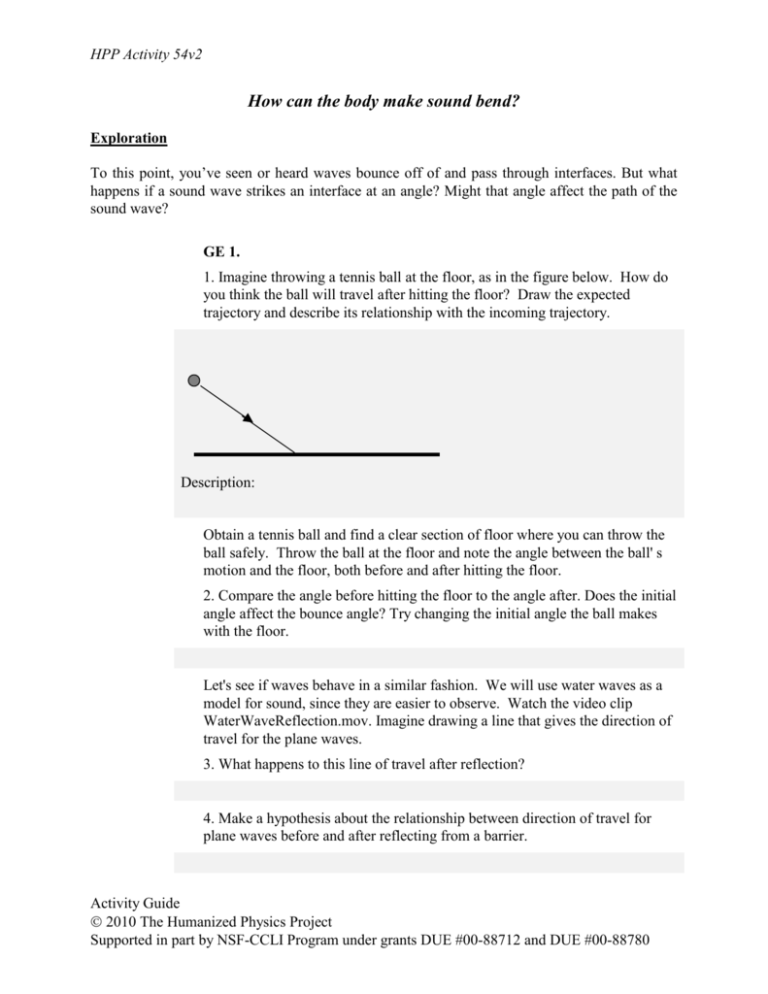
HPP Activity 54v2 How can the body make sound bend? Exploration To this point, you’ve seen or heard waves bounce off of and pass through interfaces. But what happens if a sound wave strikes an interface at an angle? Might that angle affect the path of the sound wave? GE 1. 1. Imagine throwing a tennis ball at the floor, as in the figure below. How do you think the ball will travel after hitting the floor? Draw the expected trajectory and describe its relationship with the incoming trajectory. Description: Obtain a tennis ball and find a clear section of floor where you can throw the ball safely. Throw the ball at the floor and note the angle between the ball' s motion and the floor, both before and after hitting the floor. 2. Compare the angle before hitting the floor to the angle after. Does the initial angle affect the bounce angle? Try changing the initial angle the ball makes with the floor. Let's see if waves behave in a similar fashion. We will use water waves as a model for sound, since they are easier to observe. Watch the video clip WaterWaveReflection.mov. Imagine drawing a line that gives the direction of travel for the plane waves. 3. What happens to this line of travel after reflection? 4. Make a hypothesis about the relationship between direction of travel for plane waves before and after reflecting from a barrier. Activity Guide 2010 The Humanized Physics Project Supported in part by NSF-CCLI Program under grants DUE #00-88712 and DUE #00-88780 HPP Activity 54v2 2 Invention When discussing how a wave interacts with an interface we will measure angles with respect to the normal to the surface. The word normal means perpendicular. The figure below shows the normal to the surface. Normal direction surface Figure 1. If a plane wave approaches an interface and reflects we will describe the situation by measuring the angle between the direction of travel and the surface normal. We define the incident angle, i , and the reflected angle, r , as in the following figure. i r Figure 2. The law of reflection for plane waves, including sound waves, can be stated as incident angle = reflected angle or i = r (1) Application GE 2. The figure below shows a plane wave (the two short parallel lines) incident on (moving toward) a barrier (the heavy vertical line). Activity Guide 2010 The Humanized Physics Project HPP Activity 54v2 3 Figure 3. 1. You will need to make a quantitative prediction for the reflected angle. Assume that you have a printout of the figure. Describe the steps you must you go through to find the reflected angle? Discuss your proposed steps with your instructor. What tools, if any, do you need? 2. Obtain a print out of the figure and find the reflected angle. Exploration The situation studied above corresponds to an interface between two regions where the second region has a much larger acoustic impedance than the first. This would be the case for sound in air incident on a brick wall, like the parking lot echoes studied earlier. Interfaces in the human body usually do not involve such large changes in acoustic impedance – they are more like the two springs in the last activity. What happens to a sound wave in this case? We will again use a water wave as a model for a sound wave, since it is a little easier to visualize. Observe the video clip MediumWave.mov. This shows a plane wave incident on an interface dividing two regions of water with different wave speeds (due to a change in water depth). GE 3. 1. What happens to the direction of travel of the plane wave as it enters the new region? 2. Can you identify any other changes in the wave as it moves from one region to another? Describes any changes you see and discuss them with your instructor. Activity Guide 2010 The Humanized Physics Project HPP Activity 54v2 4 To establish a quantitative description of what happens we need to measure the direction of travel of the plane wave with respect to the interface normal. The figure below shows a plane wave incident on an interface between regions where the wave speed decreases. Incident direction of travel and transmitted direction of travel are drawn, as is a normal to the interface. Figure 4. 3. Express a rule for how the direction of travel changes with respect to the normal as the wave enters the new region. Hint: Compare the direction of travel to the normal to the interface. The figure below shows a plane wave incident on a region in which the wave speed increases. Figure 5. 4. Express a rule for the direction of travel changes with respect to the normal as the wave enters the new region. See the hint in question 3. Activity Guide 2010 The Humanized Physics Project HPP Activity 54v2 5 The incident angle for the wave is defined as before, in the case of reflection. Now, we also define the refracted angle, which is measured from the normal to the transmitted wave direction, as in the figure below. Figure 6. We need to develop a mathematical model that relates the incident angle to the refracted angle. The figure below shows data for sound waves going from region 1 to region 2 where v2/v1 < 1. You can ask the instructor for a printout of the figure. You will also need a protractor. Activity Guide 2010 The Humanized Physics Project HPP Activity 54v2 Activity Guide 2010 The Humanized Physics Project 6 HPP Activity 54v2 7 GE 4. 1. Collect data on incident and refracted angles. Remember to measure with respect to the normal. Trial 1 2 1 2 3 4 5 6 2. Copy your data to Excel and graph the refracted angle as a function of the incident angle. Describe the graph you obtained in the space below. Is your data linear? If not, then there must be some other functional relationship. 3. Create two new columns in Excel and calculate the sine of the refracted angle in the first column and the sine of the incident angle in the second column. Excel only knows angles in radians so ask your instructor to help you convert your angles in degrees to radians before calculating the sines! Create a graph from these new columns. Describe the data in the space below. 4. Find the equation of the best-fit line that relates the sines of the two variables. Should the intercept be zero? Make sure you display the equation and the R-squared value on the graph and then paste it here. Invention The exact relationship between refracted and incident angles for a wave traveling from one region to another is called Snell's law. Consider the geometry shown below. Activity Guide 2010 The Humanized Physics Project HPP Activity 54v2 8 Figure 7. Snell's law states that sin( 2 ) v2 (2) constant sin( 1 ) v1 Usually there is both reflection and transmission with refraction at an interface. We omitted drawing the reflected waves in figures 4-7 above, for the sake of clarity. GE 5. Compare the equation for your best-fit line in GE 4 to Snell’s law. 1. Write your equation in the space below. Remember, you graphed sin(1) versus sin(2)! 2. What are the variables? 2. What is the slope of your line and what are the corresponding elements in Snell’s Law? 3. Based on Snell’s Law above, what should be the intercept of your equation in GE 4? 4. Based on your answers to 1-3, is your equation from GE 4 just another version of Snell’s Law? Explain your answer to your instructor. Activity Guide 2010 The Humanized Physics Project HPP Activity 54v2 9 Application Now that we have a quantitative understanding of waves traveling from one substance to another through the interface between the two substances, let us apply what we’ve learned to sound waves traveling through a body. GE 6. Suppose a plane sound wave in fat hits a layer of muscle with an incident angle of 20º. What would be the refracted angle of the sound wave in muscle? Let's approach this problem in a couple of steps. 1. According the Snell's law, what properties of fat and muscle must we know to apply the law? 2. Look up the necessary tissue properties and record them here. Activity 2 should be useful here! 3. Make a diagram showing the geometry of the situation. Identify the interface, the normal to the interface, the incident wave, the refracted wave, and the reflected wave. 4. Calculate the refracted angle. 5. Compare the incident and refracted angle. If these angles were substantially different, would it be possible to construct an accurate picture of the interior of the body. Explain Invention The discussion above showed how we can predict reflected and refracted angles when sound hits an interface. Another important issue in ultrasound is how much of an incident wave gets Activity Guide 2010 The Humanized Physics Project HPP Activity 54v2 10 reflected and how much gets transmitted. Review the two movies Twosprings.mov and Twosprings2.mov. The two movies involve the same springs but the initial pulse starts out in different springs. GE 7. Compare the two movies while carefully noting the relative amplitudes of the incident, reflected, and transmitted pulse. 1. Is the reflected pulse the same size, smaller, or larger than the incident pulse in each movie? 2. Is the transmitted pulse the same size, smaller, or larger than the incident pulse in each movie? 3. Do the amplitudes of the reflected and transmitted pulses (relative to their incident pulse) depend on the way they pass through the interface? The amount of reflection and transmission can be described by defining the reflection and transmission coefficients. These are easy to define for the case of zero incident angle. This case is given here. The reflection coefficient R is R Z1 Z 2 (3) Z1 Z 2 where Z1 and Z2 are the acoustic impedances for region one and region two. The transmission coefficient for this case is T 2Z 2 Z1 Z 2 (4) Application GE 8. Compare the amount of reflection from a fat-muscle interface and a musclebone interface. You may assume that the incident wave makes a zero degree angle with respect to the normal, that is, the direction of travel is perpendicular to the interface, in each case. 1. Draw a diagram of the situation, showing incident wave and interface. Activity Guide 2010 The Humanized Physics Project HPP Activity 54v2 11 2. What tissue properties must you know to make the comparison? 3. Find the appropriate tissue properties and record them below. 4. Which interface reflects the most? Explain how you know. Activity Guide 2010 The Humanized Physics Project


